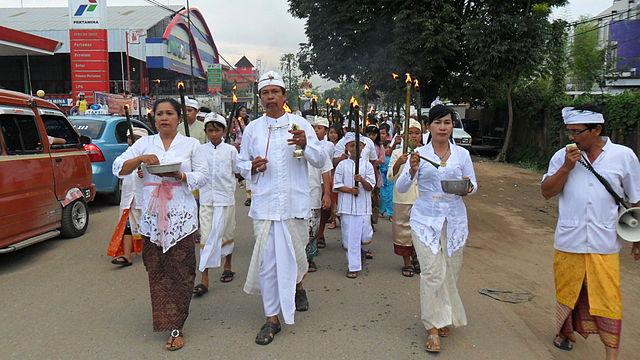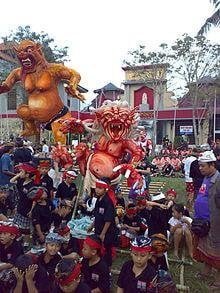Translation from Indonesian to English of Jelang Nyepi, Tiga Ornamen Simbol Umat Hindu Dirusak Orang tak Dikenal by Google Translate.
“LUMAJANG – The tranquility of the Tenggerese Hindus in Lumajang, East Java is disturbed ahead of the Nyepi celebration. There was destruction of three religious symbols in the form of patmasari or ornaments on the edge of the road. Now, the police are still investigating this case.

The police line was installed at the location of the destruction of Hindu religious symbols in Argosari Village, Senduro District. Three ornaments which are usually used as a reminder place for YME installed on every corner of the village road, were damaged by unknown people.
Ismail, Argosari Village Chief, explained, it was not yet known when the ornaments were damaged.
“But from some residents’ information, it was alleged that the building was damaged on Tuesday morning,” Ismail said.
The destruction of the symbol of the Hindu religion worship received serious attention from Thoriqul Haq, Regent of Lumajang. He went directly to the location to find out the chronology and the scene.”
Read the original article in Indonesian language at Jelang Nyepi, Tiga Ornamen Simbol Umat Hindu Dirusak Orang tak Dikenal
The Hindus in Bali are strongly religious. All ages, except babies seem to be wholeheartedly bound to the observance of the prayer. Women wear kebaya and have their hair twisted while men appear in white with udang (traditional headdress) on their head. They will march under golden yellow sunshades which are meant for ritual ceremonies.

Tawur Kesanga, a ritual procession on the eve of Nyepi, celebrated a day before. The children carry flame torches, that lit bonfires to symbolically burn ogoh ogoh monster evil spirits.
One day before Nyepi, there is the Tawur Kasanga ceremony. The ceremony is held in every place of the island, from the front yard through the city pura. Every house has merajan to adorn with Panca Warna offerings. Sanggah cucuk of bamboo cane are positioned against the door to display colorful gifts of sacrifice, such as āketupatā (cooked rice in square of coconut leaves), tumpeng (cone rice), chicken and other food, and rice wine, liquor, and water presented under the bamboo.

The last day of the year includes processions of Bhuta (demons, above), followed by Nyepi, the festival of silence.
According to Wikipedia, Nyepi is a Balinese “Day of Silence” that is commemorated every Isakawarsa (Saka new year) according to the Balinese calendar (in 2019, it falls on March 7). It is a Hindu celebration mainly celebrated in Bali, Indonesia and in East Java.
Many Hindus in South Asia observe the same day as new year. For example, the Hindus of Maharashtra term the same festival, observed on the same day, Gudi Padwa (Marathi: गुढी पाडवा). The Sindhis, people from Sindh, celebrate the same day as Cheti Chand, which is the beginning of their calendar year. Manipuris also celebrate their New Year as Sajibu Nongma Panba on the same day. The Hindus of Andhra Pradesh and Karnataka also celebrate their new year on the same day as Ugadi.

